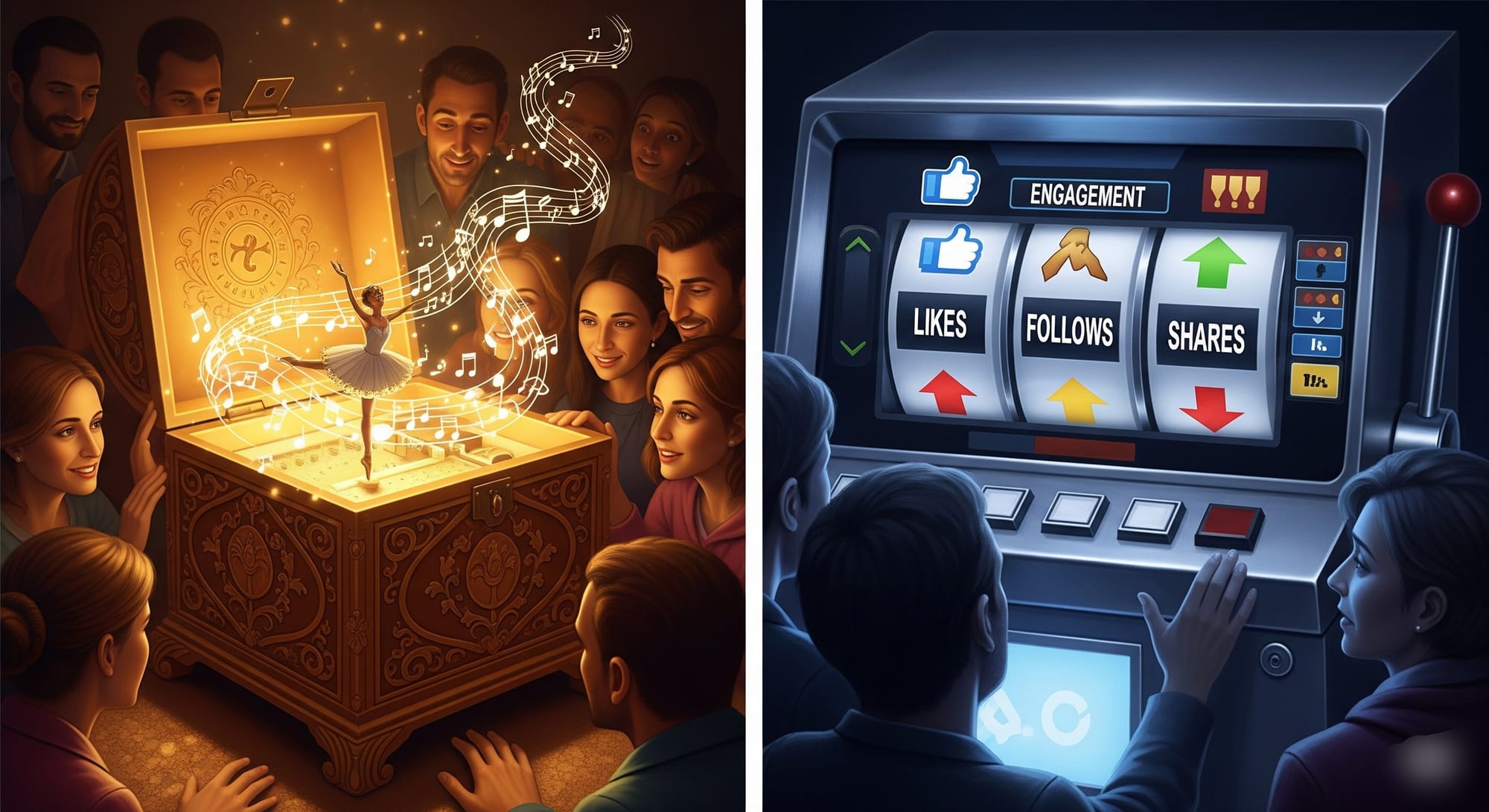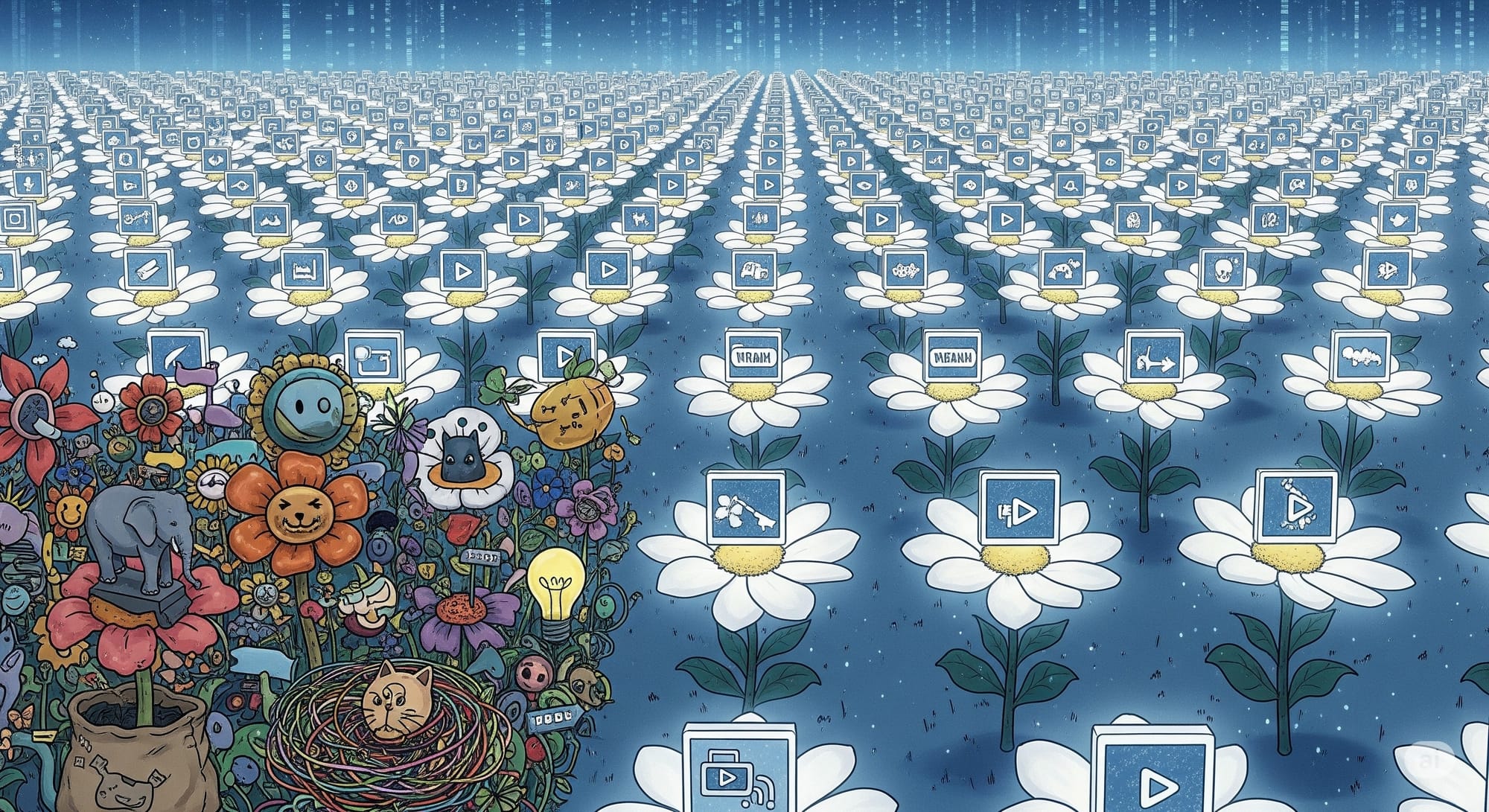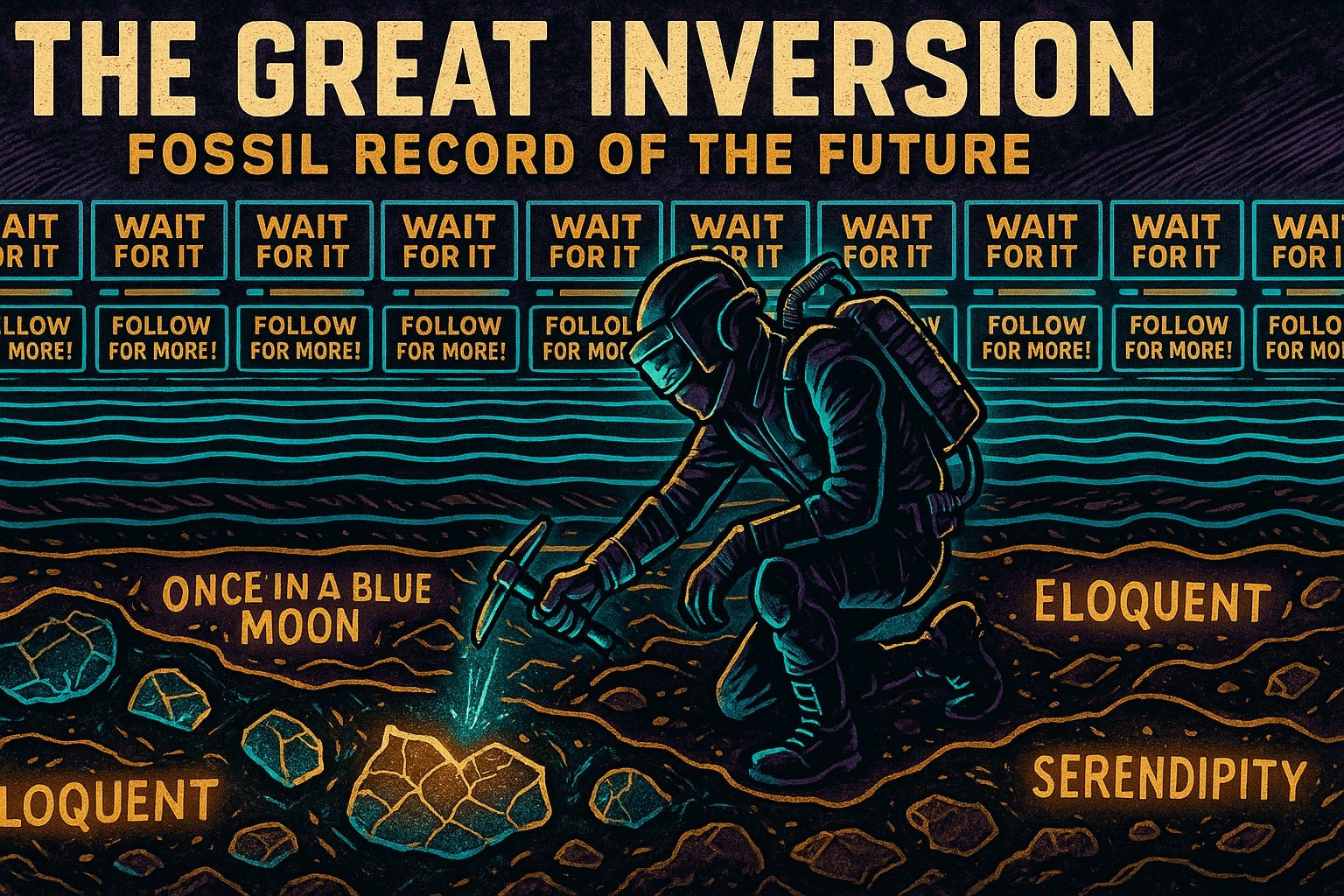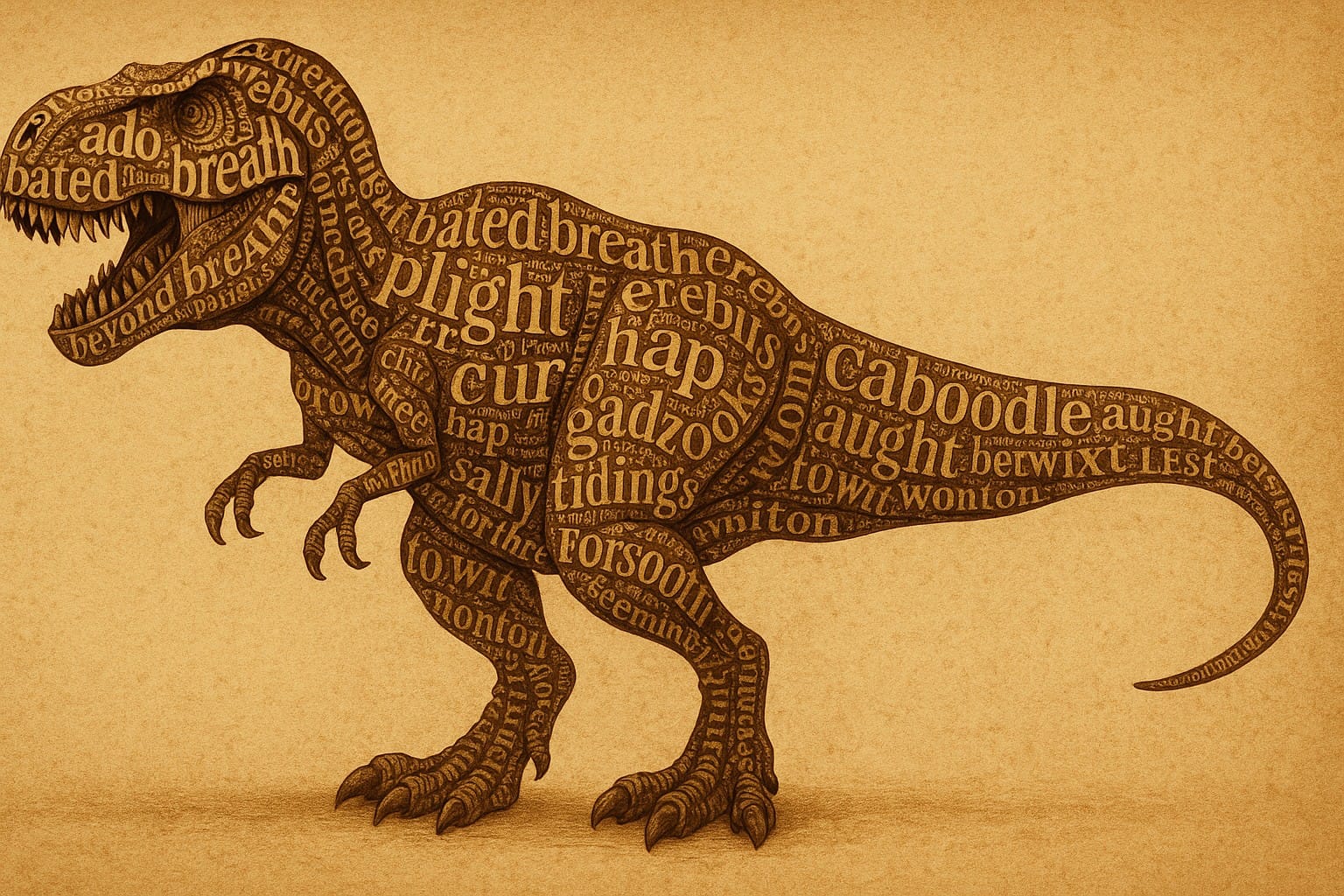Two Kinds of Cultural Preservation
Picture this: You’re at a dinner party, and someone says “without further ado” before launching into a toast. Nobody blinks. Nobody asks what “ado” means. Yet if you cornered any of these well-educated people and demanded define “ado,” most would fumble like they’re trying to explain cryptocurrency to their grandmother.
That’s the magic of a fossil word—a 500-year-old linguistic ghost that haunts our everyday speech, perfectly preserved in the amber of idiom.
Now flip out your phone. Open TikTok. The dance you were obsessed with last Tuesday? Dead. Deader than “ado” as a standalone word. The algorithm has moved on, and so has everyone else.
Welcome to the paradox of our age: We live simultaneously in two preservation systems—one that keeps ancient words alive for centuries without us even knowing what they mean, and another that can make or break cultural phenomena in the time to microwave leftovers.
Here’s where it gets interesting. Both systems act as memory keepers for our culture. Language evolution has been stockpiling obsolete words in our idioms like a linguistic prepper storing canned goods for the apocalypse.
Meanwhile, algorithmic systems are supposedly preserving our digital culture, but they’re doing it with all the subtlety of a reality TV producer—amplifying the dramatic, killing the nuanced, and turning everything into a competition for attention.
The question worth asking over our metaphorical coffee is this: Which system is preserving culture, and which is just preserving engagement metrics dressed up as culture?
The Natural Preservation System: How Language Keeps Its Secrets
Before we dive into the digital dystopia, let’s appreciate the elegant chaos of how language naturally preserves its history. You’ve been speaking in code your entire life without realizing it.
Every time you say someone’s “beyond the pale” or you’re waiting with “bated breath,” you’re speaking in linguistic hieroglyphics that would make an ancient Egyptian proud.
Think of idioms as linguistic amber—that golden, prehistoric tree resin that perfectly preserved mosquitoes so we could eventually clone dinosaurs (thanks, Jurassic Park). Instead of insects, we’re preserving words that would otherwise be as dead as Latin.
“Pale” once meant a fence or boundary. “Bated” is just “abated” after a few centuries of linguistic telephone. These words should be extinct, but idioms wrapped them up in semantic bubble wrap and shipped them straight to the 21st century.
The beautiful thing about this system is its complete lack of intention. Nobody sat down in 1523 and said, “You know what? Let’s make sure future generations know about ‘ado’ by sticking it in a phrase.”
It just...happened like how your junk drawer somehow preserves artifacts from every era of your life—that Nokia charger, those mystery keys, the business card from that job you quit in 2019. Natural language is the ultimate junk drawer, except everything in it still works.
This creates a “linguistic biodiversity.” Just as a healthy ecosystem needs weird little creatures doing incomprehensible things in dark corners, a healthy language needs these fossil-words lurking in our idioms. They add depth, texture, and the kind of historical resonance that makes English feel less like a communication tool and more like a time machine you operate with your mouth.
The key insight here is that language evolution naturally balances innovation with conservation. New words flood in (hello, “ghosting” and “doomscrolling”), but the old ones don’t necessarily die. They find rent-controlled apartments in our idioms and live there forever, like that couple in Manhattan who’ve been paying $500 a month since 1978.

The Artificial Preservation System: How Algorithms Choose Our Culture
Let’s pivot to the other preservation system—the one that’s about as natural as a Twinkie and just as likely to survive a nuclear apocalypse.
Algorithmic content curation is what happens when you let a computer program with the emotional intelligence of a slot machine decide what culture gets preserved.
Here’s how algorithmic pandering works: Imagine you’re a street performer, but instead of humans tossing coins in your hat, you’re performing for a deeply inscrutable robot overlord who rewards you based on criteria you can only guess at.
Did the robot like your juggling? Your singing? The way you wore your hat?
Who knows!
All you know is that when you wore the red hat and juggled flaming batons while hopping on one foot, the robot made it rain.
So, guess what you’re doing tomorrow? And the next day? And forever?
That’s every content creator on every platform right now.
They’re not creating for humans anymore; they’re creating for the algorithm’s twisted idea of what humans want. It’s like cooking for someone who only communicates through vague grunts and occasionally throws either money or rotten tomatoes at you.
The result?
Homogenization on a scale that makes factory farmers jealous.
Every thumbnail looks the same (mouth open, arrows pointing at nothing, “YOU WON’T BELIEVE”). Every video follows the same formula (hook in the first three seconds, manufactured drama, call to action). Every piece of content is optimized within an inch of its life until all the actual life has been squeezed out like the last bit of toothpaste from the tube.
But here’s the kicker: Unlike our linguistic fossils, which preserve diversity across centuries, algorithmic “preservation” is like that machine in “The Fly” that was supposed to teleport Jeff Goldblum but accidentally mixed him with an insect.
The algorithm takes human creativity, mixes it with engagement metrics, and spits out this horrifying hybrid that’s technically successful but fundamentally inhuman.
The algorithm preserves what drives engagement, not what’s culturally valuable. It’s the difference between a museum and a casino. Both preserve things, but one preserves Van Goghs and the other preserves the exact psychological conditions that make you lose your mortgage payment.

The Great Inversion: When Machines Decide What Survives
This is where our two preservation systems reveal themselves as perfect opposites, like matter and antimatter, or Twitter err X and nuanced discourse.
Let’s talk speed first.
Linguistic fossilization moves at the pace of continental drift. It took “ado” about 500 years to go from a regular word meaning “fuss” to a fossil that only exists in our idioms.
That’s roughly 25 generations of humans slowly forgetting what a word means while somehow still using it perfectly in context. It’s like your family passing down a recipe for centuries, where nobody remembers what “fold in the cheese” means, but everyone keeps doing that weird thing with the spoon that somehow works.
Algorithmic fossilization? That happens while you’re in the bathroom.
A meme format, a video style, a whole aesthetic can go from revolutionary to mandatory to cringe to ironically revived to genuinely dead in about six weeks. The algorithm doesn’t just speed up cultural evolution; it puts it in a particle accelerator and watches the explosions.
Now, diversity versus homogenization—this is where it gets properly dystopian.
Natural language is like that friend’s spice cabinet, where you find saffron from their trip to Morocco next to something labelled “mystery powder—probably oregano?” Every idiom preserves a different slice of history, a distinct cultural moment, a different way of seeing the world.
Algorithms? They’re more like a suburban mall food court. Sure, there are different restaurants, but they’re all serving variations of the same deep-fried everything to meet the same corporate-mandated profit margins.
The algorithm doesn’t want diversity; it wants predictable success. It’s the cultural equivalent of monoculture farming—efficient, scalable, and about as enjoyable as watching corn grow in Iowa.
The transparency issue adds another layer to this paradox. With fossil words, we don’t know what they mean, but the idioms work perfectly. It’s honest ignorance.
We’re all walking around saying “the whole kit and caboodle” without knowing that “caboodle” came from a Dutch phrase about household goods, and that’s fine. The meaning is clear even if the etymology isn’t.
With algorithms, we don’t know how they work, but we have to pretend we do.
It’s enforced ignorance masquerading as expertise. Creators develop elaborate cargo cult theories about what the algorithm wants. “Post at 3:47 PM on Tuesdays!” “Use exactly 7 hashtags!” “Sacrifice a goat under the full moon!” They’re doing rain dances for engagement, and occasionally it works just enough to reinforce the superstition.
But here’s the inversion: Linguistic fossils preserve human choices across time.
Every idiom represents countless humans choosing to say something a certain way until it sticks. It’s democracy in slow motion, consensus through repetition.
Algorithmic systems? They increasingly make choices for humans. The algorithm decides what you see, which shapes what you create, which shapes what others see, which shapes what they produce.
It’s a feedback loop that makes human choice look like a quaint relic—ironically, like something you’d preserve in an idiom.

The Black Box Parallel: Hidden Mechanisms, Visible Effects
Both systems operate as black boxes, but comparing them is like comparing a mysterious antique music box that plays a beautiful tune through unknown mechanisms versus a slot machine that’s specifically designed to separate you from your money through equally unknown mechanisms.
Same opacity, wildly different intentions.
When you use a fossil word in an idiom, you’re participating in a benign mystery.
You say someone’s “at your beck and call” without knowing that “beck” means a gesture of command. The black box of linguistic history doesn’t demand anything from you.
It just sits there, humming along, adding richness to your language without requiring your comprehension or compliance. It’s like driving a car without understanding internal combustion—ignorance without consequence.
The algorithmic black box? That’s a different beast entirely.
You consume content without knowing why it was selected, sure, but more importantly, you must optimize for this system without understanding it.
It’s like being forced to take a test where not only don’t you know the questions, but the grading criteria changes every time based on factors that might include the phase of the moon, the teacher’s blood sugar levels, and whether Mercury is in retrograde.
The effects ripple outward.
With fossil words, the visible impact is cultural continuity. We’re all unknowingly connected to centuries of English speakers who complained about “much ado about nothing.”
It’s like we’re all part of this massive, unconscious tradition of linguistic preservation. Nobody planned it, nobody manages it, but it works beautifully.
With algorithms, the visible effect is behavioural modification on a massive scale.
Millions of creators, all making the same creative choices, not because they want to, but because the black box rewards those choices. It’s like watching evolution in fast-forward, if evolution were being directed by a committee of engagement metrics rather than natural selection.
The crucial difference is this: One black box preserves cultural memory through benign neglect. The other shapes cultural production through active manipulation.
One is a time capsule we’re accidentally creating. The other is a behaviour modification chamber we’re voluntarily entering every time we open an app.
What We’re Losing and What We’re Gaining
Let me paint you a picture of what we’re losing.
Imagine if every idiom in English had to prove its engagement metrics to survive.
“Beyond the pale”? Sorry, not enough clicks.
“Bated breath”? The 18-34 demographic doesn’t respond well to respiratory metaphors.
“Kit and caboodle”? Our A/B testing shows that “stuff and things” performs 37% better.
The thought experiment reveals the absurdity.
Algorithmic homogenization isn’t just making content boring—it’s actively destroying the conditions that create linguistic diversity.
Languages develop weird, beautiful, inexplicable features because humans are funny, beautiful, and baffling. But algorithms don’t want weird. They want optimized. They want predictable. They want whatever worked yesterday to work again today, forever and ever, amen.
We’re creating our own fossil behaviours, but they’re fossils of optimization rather than culture.
In fifty years, digital archaeologists will unearth countless videos that all start with “Wait for it...” and end with “Follow for more!”
They’ll find millions of thumbnails with red arrows pointing at nothing.
They’ll discover that every food video from 2025 was shot from directly above while hands moved ingredients around at 2x speed. But will they find diversity? Will they find the weird, extraordinary outliers that make culture interesting?
Here’s what we’re gaining, though, and I’ll try to be fair to our algorithmic overlords: unprecedented speed of cultural transmission, global reach for creators, and the ability to find niche communities.
The algorithm, for all its faults, can connect a person interested in 15th-century lute music with others who share that passion. That’s not nothing.
But—and this is a Kim Kardashian-sized but—we’re gaining this at the cost of cultural diversity that took millennia to develop.
It’s like trading a rainforest for a very efficient palm oil plantation.
Sure, the plantation produces more of what the market wants, but we’ve lost something irreplaceable in the process.
The question I ask myself: Will future generations find linguistic diversity in their digital artifacts, or will they find the algorithmic equivalent of a million iterations of the same optimized phrase?
Will they discover the rich tapestry of human expression, or will they uncover endless variations of “HEY GUYS WELCOME BACK TO MY CHANNEL”?

Toward Algorithmic Wisdom: Learning from Language
So, what can our algorithmic overlords learn from the humble fossil word?
Quite a bit if they’re willing to trade some short-term engagement for long-term cultural value.
Natural language evolution has a brilliant feature: it’s inefficient by design.
Not every word needs to justify its existence with daily usage statistics.
Some words hang around in idioms, adding flavour, maintaining connections to our past, creating space for play and poetry.
“Vim and vigour” doesn’t need to prove it drives more engagement than “energy and enthusiasm.” It just needs to exist, carrying its little cargo of historical meaning through time.
What if we designed algorithms that actively preserved diversity rather than eliminated it?
Imagine a recommendation system that said, “Hey, I know you usually watch reaction videos, but here’s something completely different that deserves to exist.” An algorithm that valued the weird, the niche, the historically significant alongside the popular.
An “algorithmic biodiversity”—systems that maintain cultural and linguistic richness, the way a healthy ecosystem maintains species that don’t seem immediately useful.
Sure, the creator making historically accurate medieval cooking videos only gets 10K views per video. But in the linguistic fossil model, they’re preserving something valuable. They’re the “ado” of content creation—not necessarily thriving, but essential to the overall health of the system.
The current model is like managing a language where every word has to prove its ROI quarterly or get fired.
Imagine if “petard” had to justify its existence beyond appearing in one Shakespeare quote about being “hoist with his own petard.” It would be gone, and we’d lose this perfect metaphor for being destroyed by your own weapon.
The algorithm would probably replace it with “cancelled by your own tweet,” which, while accurate, lacks a certain je ne sais quoi.
Here’s a modest proposal: What if platforms had a “fossil word fund”?
A percentage of promotion dedicated to preserving culturally valuable but not necessarily viral content? What if the algorithm had a “diversity quota” not for demographics but for creative approaches? What if we optimized for cultural richness over engagement?
I can hear the venture capitalists screaming from here. “But the engagement metrics! The quarterly earnings!”
To which I say: Look at language. It’s been running successfully for millennia without a single KPI dashboard. It preserves the useful and the useless with equal dedication. It values history alongside innovation. It creates space for both efficiency and poetry.
The stakes couldn’t be higher.
We’re choosing between a future where creativity fossilizes in algorithms, frozen in whatever formation drives the most engagement, versus one where it flowers in human expression, creating new idioms, new fossil words, new ways of being human in language.
Do we want our cultural artifacts to be like linguistic fossils, preserved by accident and tradition, carrying the full weight and wonder of human history?
Or do we want them to be algorithmic fossils, preserved by optimization, carrying only what survived the brutal natural selection of the engagement economy?
Here’s the truth about fossils: The ones worth finding are the ones that show us the full diversity of what once lived, not just the ones that were most successful at reproducing.
A world where only the most engaging content survives is like a fossil record containing nothing but cockroaches.
Sure, they’re incredibly successful, but wouldn’t you rather find a dinosaur?
The algorithm is writing our cultural future in real-time, deciding what survives and what vanishes. Unlike the slow, democratic process that gave us “without further ado,” this preservation system is fast, centralized, and optimized for a single metric: keeping you scrolling.
So, the next time you use a fossil word without knowing what it means, take a moment to appreciate the beautiful inefficiency of it all.
That word survived not because it drove engagement or maximized time-on-page, but because humans kept saying it, generation after generation, wrapped safely in its idiomatic amber.
And the next time you see every creator on a platform doing the same thing, remember: That’s not culture. That’s not preservation. That’s just the algorithm, turning the rich biodiversity of human creativity into a monoculture of optimized content.
We have a choice.
We can demand algorithms preserve language like language does—messily, inefficiently, but with respect for the full spectrum of human expression.
Or we can accept a future where culture fossilizes not in the amber of tradition but in the cold logic of engagement metrics.
Without further ado—and yes, I still really don’t know what “ado” means—let’s choose wisely.
I don't sell memberships or anything, but if you want to buy me a beer, I won't refuse.


